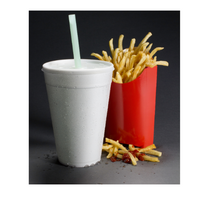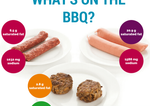Kitchen confidential: fast food industry tactics exposed
by Anne Finch, Accredited Practising Dietitian for LiveLighter
- April 13, 2021
- Leave a comment
- Families
- Health professionals
- Marketing
- Mythbusting
- Shopping
- Industry
- Junk Food
- Psychology
- Public Health
- Advocacy

If you’ve ever peeled open a burger to shove shreds of limp lettuce back into a puddle of semi-transparent mayonnaise and wondered… “why am I eating this again?”, we might have some answers for you.
Fast food ‘restaurants’ aren’t just about the food. The whole experience is carefully designed to get people coming back for more. The amount of time, energy and money spent getting you hooked is EYE-WATERING. We’re exposing some of the industry tactics to help you identify when you’re being tricked and defend yourself against these dodgy marketing techniques. Ready?
Upsizing
It’s a classic. It’s basically selling us more food than we need, and we get sucked in because it feels like “bad value” to turn down a cheap upgrade. In many fast food operations, the actual food isn’t the biggest part of their operating cost. In fact, giving us an extra scoop of fries or an extra slurp of post-mix cola costs them hardly anything, but their returns are priceless. These tactics make us feel stuffed and we equate that with good value. That helps us turn loyal customers.

Ads, eye-tracking and personalised marketing
The advertising budget of the big fast food companies is mind blowing. They spent $11 million buying traditional ad space (like TV, billboards and bus stops) in the 12 months between July 2019 and August 2020 in Western Australia alone. This $11 million doesn’t even include the budget for making the ads, paying the sell-ebrities, or orchestrating the PR stunts.
Critically, this $11 million also doesn’t include online advertising spend – and we know that this is becoming a bigger and bigger part of the marketing mix. Online advertising is in our pocket and follows us everywhere! Some of the stuff that can be done with digital technology is frankly… creepy. Some digital billboards have eye-tracking technology and can tell what ads you’re looking at. Apps can use your GPS signal to serve us ads for a particular fast food outlets when we’re in range of that outlet. Facial recognition technology on digital billboards can show us specific ads based on our appearance. This is only the tip of the iceberg in a rapidly moving technology environment.
Bliss point
Have you heard of the bliss point? No? You’ve probably experienced it. It’s when there’s juuuust the right combination of sugar, fat and salt to make a food very more-ish. It’s when you find it hard to stop eating even though you’re getting uncomfortably full. Food manufacturers spend squillions developing and testing food formulations in a lab to find this bliss point. And the result is food products that are specifically designed to override our natural fullness signals. This encourages us to buy and eat more than we need. These highly processed junk foods replace cheaper and more nourishing foods, and can easily lead to overeating (but being undernourished when it comes to the essentials like vitamins and minerals!).

Health halo
Most fast food places have a “healthy” option these days. The sad salad option is almost always undermarketed and overpriced. It’s a good way to get people in the door, and it makes the industry look like the “good guys”. But what the fast food giants really want is to sell the cheap ingredients with the nice big markups! The hardest part to swallow, is that the salads are often not even that nutritious. They’re often doused in dressing and served with bacon, cheese and fried meat. That means there’s way more energy (kilojoules or calories) than people expect, and a tonne of added sugar, saturated fat and salt.
Pester power
Did you know that there are hardly any rules about how companies can advertise to kids? And, hilariously, the junk food industry invented their own rules and police themselves? Spoiler alert: this system is failing to protect children from predatory marketing practices. We see the marketing of unhealthy foods to kids via characters, toys, playgrounds, partnerships, product tie-ins and sponsorships. We see fast food restaurants clustered around high schools and areas of greater economic disadvantage. pretty gross.

Parents Voice is a great network to join if you want to learn more and advocate for healthier environments for kids. Our Kids, Our Call is another great movement with tools to stop junk food advertisers targeting our kids and help your family establish healthy habits for life.
Fast food is big business. Being savvy to the industry tactics can help us avoid being sucked in to the siren song of cheap, heavily marketed, nutrient-poor convenience food. Don’t let junk food become every day food.







